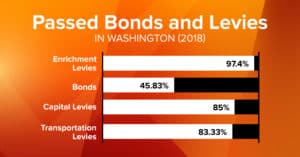2020 Legislative Priority: Fair Local K-12 Funding
By League of Education Voters Policy Team
In the 2020 legislative session, League of Education Voters will prioritize policies to help lay the foundation of an equitable educational system that provides what students need, when and where they need it.
We believe students come first, and we are dedicated to designing an equitable education system that serves all students based on their strengths, supports their needs, and provides the resources they need to be successful.
We are dedicated to designing an equitable education system that serves all students based on their strengths, supports their needs, and provides the resources they need to be successful.
We are committed to working to close gaps experienced by historically and systemically underserved students — including students of color, students in poverty, students qualifying for special education services, students learning English, and students impacted by trauma.
We believe this will lead to all students experiencing greater success and reaching their full potential.
BACKGROUND

Historically, local levies have provided about one quarter of K-12 education funding in Washington state, amounting to $2.6 billion in school year 2018-19. In 2018-19, districts raised an average of $2,395 per student in local levy funding, with levies ranging from $86 per student in some districts to over $4,000 in others. This difference is driven not only by the levy rates, or amounts that district voters agree to tax themselves, but also by the property values in a district.
For example, in 2018-19 one district passed a levy of about $1.13 per $1,000 of assessed value and raised $198 per student, while a higher property value district passed a similar levy of $1.14 per $1,000 of assessed value to raise $4,381 per student. (1)
WHAT HAS CHANGED?
As part of the legislative solution to fully fund basic education, several changes were made to how much districts can raise through the levy system, the most recent of which went into effect in January 2020. The two biggest changes to the levy system included changing the formula used to calculate how much districts can raise through levies and placing a lower overall limit on the amount districts can raise per student. (2) Read More
 Historically, local levies have provided about one quarter of K-12 education funding in Washington state, amounting to $2.6 billion in school year 2018-19. In 2018-19, districts raised an average of $2,395 per student in local levy funding, with levies ranging from $86 per student in some districts to over $4,000 in others. This difference is driven not only by the levy rates, or amounts that district voters agree to tax themselves, but also by the property values in a district.
Historically, local levies have provided about one quarter of K-12 education funding in Washington state, amounting to $2.6 billion in school year 2018-19. In 2018-19, districts raised an average of $2,395 per student in local levy funding, with levies ranging from $86 per student in some districts to over $4,000 in others. This difference is driven not only by the levy rates, or amounts that district voters agree to tax themselves, but also by the property values in a district. By Jacob Vela, Senior Policy Analyst
By Jacob Vela, Senior Policy Analyst By Daniel Zavala, League of Education Voters Director of Policy and Government Relations
By Daniel Zavala, League of Education Voters Director of Policy and Government Relations Last month, communities across Washington state voted on local levies to continue funding for enrichment programs and capital projects at district schools. Here are the election results and my analysis.
Last month, communities across Washington state voted on local levies to continue funding for enrichment programs and capital projects at district schools. Here are the election results and my analysis.